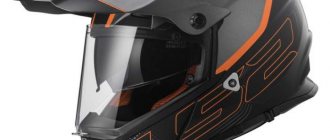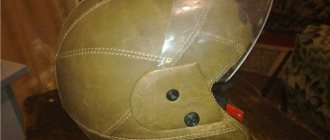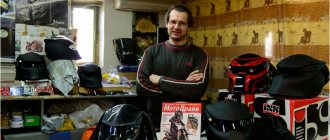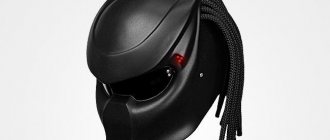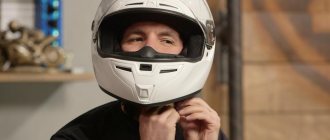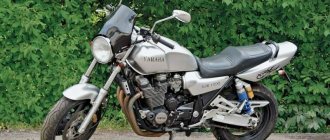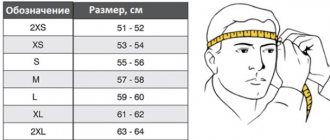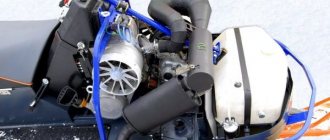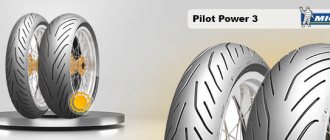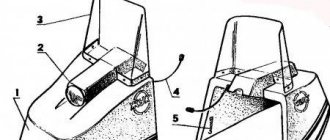There is a long and intense debate about the need for mandatory wearing of motorcycle helmets among bikers. But no one disputes the need to purchase helmets for snowmobiles. The conditions for driving a snowmobile are quite specific: from a forest with branches that are easy to hit with cones, to frost and winter wind that freezes your face at speed.
The differences between a snowmobile helmet and a motorcycle helmet are due precisely to these operating conditions. It is important for snowmobile helmets to avoid fogging up the windshield and also need protection from snow flying in your face. Of course, the helmet must perform well at low temperatures.
To protect against fogging, snowmobile helmets have double visor glasses with an air gap between them. More advanced and expensive models have internal heating, which equalizes the temperature inside the helmet with the outside temperature, which eliminates fogging even at very low temperatures. The heating element (cord) is located around the perimeter of the helmet, just like, for example, on the rear window of a car.
Snowmobile helmets also use a high deflector to keep moisture out of the visor.
Pros and cons of integral and modular
Motorcycle helmets of the “ integral ” and “ modular ” classes (aka flip-up) are very similar, but they also have enough differences. So what should you choose? After all, to the untrained eye of a beginner, these are almost the same thing. However, you should approach the choice of a helmet responsibly - after all, this is a very expensive purchase, and if you rush, you can literally throw money down the drain. Do you need it? The main difference between the integral and the modular is that the integral is a solid cast shell, while in the modular the jaw part of the helmet can be raised upward. Riding like this, however, is very uncomfortable - the jaw of a motorcycle helmet raised to the level of the forehead spoils the aerodynamics very noticeably. Yes, it is true. models that allow you to move your jaw all the way back to the back of your head, and in such helmets you can ride comfortably in both modes - both by fastening the jaw part and by sliding it back. But similar models of helmets usually cost a lot.
The classic modular is an integral with a jaw, which at the press of a button can be moved upward with one movement of the hand and fixed there.
This is, of course, convenient - you don’t have to take off your helmet to talk to someone, or to take a sip of water or have a snack. Thus, the convenience is comparable to that of 3/4 helmets, but at the same time the level of protection of the modular is much higher, and is very close to the level of protection of an integral type motorcycle helmet. There were some downsides, of course. Since the integral is a cast shell, and the modular has separate parts (the jaw and its mechanisms), under the same spherical conditions in a vacuum the integral will be stronger. The difference, of course, is small, but it is there. For motorcyclists. who put protection at the forefront, this can be a powerful argument. Another disadvantage of the modular is less impressive sound insulation. Even bought a helmet for a thousand dollars, you might be surprised by the whistle of the wind at speeds above 120-140 km/h. The fact is that whistling and noise are associated with the presence of gaps in the jaw mechanisms of the modular. Of course, in expensive motorcycle helmets they are kept to a minimum, but it is impossible to completely get rid of them, and an integral helmet in the middle price category can often boast better noise insulation than a top-end modular helmet. True, this drawback only appears at high speeds, so if you don’t ride fast, or your motorcycle has excellent wind protection, you won’t be affected by wind noise. Another distinctive feature is weight. Many motorcycle equipment manufacturers are chasing weight reduction, and helmet manufacturers in particular. The lighter the helmet, the less you get tired of it, especially during a long trip - this is a fact. And all other things being equal, the integral will weigh less than the modular, since the lifting jaw mechanism is also not weightless.
What conclusions can be drawn from the above? If you're too lazy to take off your helmet to chat with someone or drink water, if you don't ride fast, or if your bike protects you well from headwinds, the disadvantages of a modular compared to an integral are unlikely to affect you. If you have some kind of evil naked bike with a powerful motor and no wind protection, and you like to race, and also put protection above all else, then an integral is obviously suitable for you.
What types of motorcycle helmets are there?
A high-quality helmet is reliable head protection in the event of an accident or an unexpected fall from a vehicle.
But that's not all. This element of personal safety for motorcyclists reliably protects against midges, wind, sun and even small stones that can fly out from under the wheels of vehicles ahead. And very often it saves you from it. I was convinced from personal experience: I was riding a scooter without a helmet, it’s good that you don’t mess around with it too much, and once something hit my head..... From that moment on, I always ride with a helmet.
What types of helmets are there?
So, motorcycle helmets can be of four types - open, modular, cross and integral. As for the “integrals,” they are closed-type motorcycle helmets. These devices guarantee the driver the best protection from wind, dust, noise and sun. The only downside to this helmet is that it gets too hot when moving at low speeds. In addition, these helmets are quite bulky and heavy.
A few words about choosing a model
Having decided on the type of model, you need to try it on. To do this, the pilot must know his size. It is very simple to determine, for which it is enough to use a centimeter and measure the circumference of the head, while the measuring tape should pass above the ears, above the eyebrows and be sure to capture the occipital protuberance. It is necessary that the selected helmet fits your head tightly, without causing a feeling of squeezing or discomfort.
Put on the integral and move your head in different directions several times. At the same time, it should not dangle. Fasten the motorcycle helmet on your head and also make several sharp movements. If the fastened integral does not fall off, nothing interferes or presses, then the helmet is selected correctly. It should be taken into account that the integral must be put on the head, holding it by the straps and moving them to the sides. When trying on a new helmet, it may feel like there is a lot of pressure in the cheek area. However, after wearing it a few times, this feeling disappears, the helmet will “sit down” to the shape of your head and face. This happens due to the presence of special facial pads, which eliminate excess emptiness inside the shell.
What is the difference between motorcycle helmets - types and features of choice
Helmets are a real symbol for motorcyclists. You can ride a motorcycle in leather, jeans or even a business suit. You can wear motorcycle boots on your feet, but you can also wear regular sneakers or, again, classic boots. You can ride in all this, and the only important thing here is that you have a helmet on your head.
Motorcycle helmets are different, that's understandable. But with the understanding that this is not just motorcycle equipment, but something that can save lives, it is important to understand how exactly motorcycle helmets differ?
The classification of motorcycle helmets is based on the design of the shell; this is what distinguishes integral helmets, open helmets and modular helmets - these are the main types of helmets for motorcyclists.
It is believed that the most common and, therefore, the most popular is the integral helmet or full face, to call it in English. This helmet can be used if you want to have the most optimal solution for all occasions, no matter how trivial it may sound.
“Integral” completely covers the head, that is, there is also chin protection. Taking into account the fact that, according to statistics, very often in the event of an accident, impacts occur precisely on the chin area, such a helmet can be considered the safest.
What is an integral motorcycle helmet?
It is not for nothing that the integral helmet is the most common and in demand, since it is the one that is able to provide a person with the maximum level of safety. The shell is designed in such a way that the helmet completely covers the surface of the head and part of the neck. In addition, the integral minimizes the occurrence of complex fractures of the lower jaw, forehead bones and face as a whole, which, according to statistics, are most often exposed to impact during emergency situations.
If you look at the integral, you can see that it consists of a rigid shell. Helmets made of polycarbonate and thermoplastic are considered the most durable and reliable. To give strength, the shell is reinforced with fiberglass, because an integral helmet is, first of all, reliability and confidence in riding. Inside it there is an elastic layer of polystyrene and foam rubber seals. It is the inner layer of the integral that is designed to dissipate the energy of a pinpoint impact. In this regard, it is recommended to try on the helmet during purchase so that it does not dangle, but fits snugly to the surface of the face and head.
Motorcycle helmets for city driving, main types and differences
Against the backdrop of serious traffic congestion, especially in megacities, two-wheeled motor vehicles are becoming increasingly popular. And the main element of protection for comfortable motorcycle riding in urban conditions is a good helmet.
There are a large number of different types of motorcycle helmets, each of which has its own purpose for use on a specific type of motorcycle. The most famous manufacturers of helmets for city driving are: Shoei, Shark, Schuberth, LS2, HJC, AGV, Michiru, Uvex, Icon, Vega, Airoh, Arai. In this article we will look at the most popular types of motorcycle helmets for driving in urban environments.
Helmet integral
Integral is one of the most popular types of helmets for city bikes and it is so in demand, primarily due to the rise in popularity of sports motorcycles - “sportbikes”. This helmet is a one-piece and very durable structure that completely covers the rider’s head and face, similar to full faces for motocross. The integral is always equipped with an external glass visor - a visor. Some models have an additional sun visor, which is located inside the helmet, under the main outer glass.
Many models have a system for blocking the main visor from accidental opening at high speed, as well as sliders for contactless opening of the visor, which allows you to lift the visor without touching it and without leaving fingerprints on the surface of the glass.
A progressive ventilation system is most often equipped with special curtain valves, thanks to which the rider can regulate the level of airflow and, accordingly, the temperature inside the helmet depending on weather conditions. The soft hypoallergenic lining is made of breathable neoprene, which is perfectly ventilated and perfectly absorbs sweat; in addition, in almost 100% of cases, this lining can be easily removed for washing, which allows you to maintain the hygiene of the helmet, even after long trips in hot weather. Various types of fasteners are responsible for fixing it on the head, from classic D-rings to fasteners with carabiners or magnetic clips.
There are models with additional options, such as a built-in Bluetooth headset with hands-free mode, etc. But most often there are sports variants of integrals, because These helmets were primarily developed for rally racing participants, which is why they are perfect for riding a sports bike, which is capable of reaching incredible speeds. Such a helmet is capable of protecting the rider’s head even in the event of a fall at speeds over 100 km/h, because a huge margin of safety is built precisely thanks to the sports “pedigree” of these helmets. Materials, appearance, colors and graphic design can vary significantly, so each buyer can choose a helmet to suit their taste.
Glass
As for the glasses installed as visors on integrals, their thickness ranges from 2.2 to 2.5 mm. They are made from heavy-duty material that can withstand impacts and scratches. A modern integral helmet for a snowmobile or motorcycle can be equipped with two visors. One of them is installed outside the product and may have a darkened sun protection coating. It almost completely follows the curves of the helmet and has a smooth, streamlined shape, and its installation takes just a few minutes.
An integral helmet with sunglasses, which are made in the form of a built-in visor, is also very convenient to use. An example of such a model is an integral produced by Airoh (Movement Shot Black), which can be purchased for 15 thousand rubles.
Helmet modular
This is also a very popular type of motorcycle helmet for city riding, which is largely similar in its characteristics to the integral, but often weighs a little more than its sports counterpart. This is due to the fact that a motorcycle helmet is a modular combination of a main shell that protects the head and a hinged jaw, which can rise up along with the visor, completely revealing the rider’s face, hence the name of this type of helmet – modular. This solution allows you not to remove the modular helmet during short stops, for example to quench your thirst or talk on the phone, etc. The modular visor can be raised separately from the visor; it is also often equipped with a locking system against accidental opening at speed and a slider for contactless lifting.
About the Vega HD168 Bluetooth model
Let's look at the Vega HD168 Bluetooth integrated helmet, which has gained popularity among many pilots. From the name of the shell it becomes clear that this model is equipped with an integrated bluetooth system. This design feature allows the rider to fully concentrate on the road and not be distracted by looking for a mobile phone while driving. It is enough to configure the headsets of your phone and helmet, and you can receive an incoming call with one press of a button, which is located on the side of the integral. In addition, there are built-in high-quality headphones that provide the proper level of audibility. The helmet is also compatible with many models of MP-3 players.
Open type motorcycle helmets with and without visor
Open-face helmets are designed for warm-weather riding and are made as lightweight as possible to improve comfort during long bike rides on public roads. The design is based on a durable shell that perfectly protects the rider’s head, leaving the face exposed. Inside there is a soft neoprene lining that can be easily removed for washing.
Ventilation holes often do not have valves, because... It is assumed that this helmet will be used at positive temperatures, so the airflow level should be maximum by default.
The motorcycle helmet fastening system can be different - from classic D-rings to carabiners and magnetic clips. Open-type helmets can be equipped with a visor and, very rarely, an additional sun protective visor; a locking system and a slider for non-contact raising of the visor are most often absent for the sake of weight reduction and maximum simplification of the design.
Open type helmets are the most budget-friendly solution, suitable for any type of motorcycle, be it choppers, cruisers, touring bikes or even scooters. Materials, designs and graphics vary, allowing you to choose a helmet to suit every taste.
Motorcycle helmets for enduro and tourism with visor
This type of helmet is a classic version of the full face for enduro and tourism, with a design similar to motocross helmets. However, these helmets have a number of differences. For example, they are equipped with a visor similar to city helmets - integrals and modulars. Most often, the visor can be easily removed, which allows the helmet to be used with regular motorcycle goggles for motocross and enduro.
There is also often a system for adjusting the ventilation holes to ensure a comfortable temperature inside the helmet depending on weather conditions. The soft neoprene lining can be easily removed for washing. The fixation system most often consists of classical D-rings, but there are also models with carabiners. In 100% of cases, these helmets have a visor, which has an additional protective function for the face in the event of a frontal fall, and also protects the rider’s eyes from scorching sun rays, similar to motocross helmets.
Occasionally there are transforming models with a removable jaw, thanks to which the helmet can be turned into a “half-nut” (an open-type helmet) for driving in urban conditions. This type of helmet is perfect for those riders who combine urban riding with relatively extreme cross-country riding or motorcycle touring.
We looked at the main types of motorcycle helmets for city and road riding, but which one to choose is up to you, and when choosing a specific type of helmet, you should focus on the type of motorcycle, as well as personal needs and riding style.
The solutions with the highest level of protection are, of course, integrals and modulars. Lighter and more comfortable to use, open-type helmets are perfect for leisurely driving on city streets and public roads. For those who like to combine city riding with riding on difficult, rough terrain, the ideal solution would be to purchase a motorcycle helmet for enduro and tourism, equipped with a visor.
